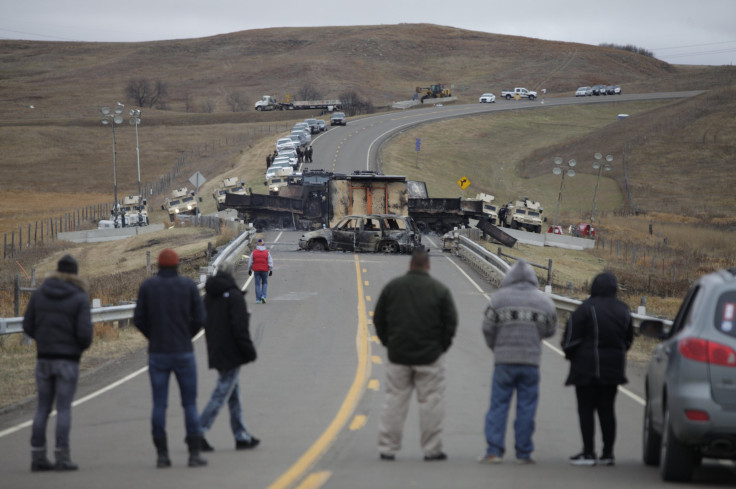What Is Standing Rock? What To Know About The Dakota Access Pipeline And Native American Rights

Activists from across the world have flocked in recent weeks to Standing Rock, North Dakota, to literally join hands with groups of Native Americans protesting a $3.7 billion oil pipeline that would carry 470,000 barrels of crude across four states. Protesters say the proposed site of the project would not only endanger members of the nearby Standing Rock Sioux Tribe by tainting their water supply, but also rip apart acres of their sacred cultural land.
The protests over fracking, climate change and how the federal government treats Native Americans started when several groups of Native Americans gathered outside the central North Dakota town of Canon Bell in April. The fight against the proposed Dakota Access Pipeline has since garnered the support of 300 Native American tribes. Activists who call themselves “Water Protectors” have raised over one million dollars to support the North Dakota protesters through online fundraising sites, CBS NEWS reported.
The heated conflict between protesters and law enforcement officers in Standing Rock seemed to reach a boiling point over the weekend when officers attempted to displace a campsite of protesters who were accused of trespassing on private land. The exchange, in which police used pepper spray and bean bags to disperse the crowd, resulted in 142 arrests and several vehicles being set ablaze on both sides of the conflict.
The battle gained further attention this week as Facebook users employed the site's check-in feature to claim they were at the reservation as a means to shield protesters from law enforcement agencies who have allegedly used the social media site in their investigations. Since last summer, police said they have arrested more than 400 people, including journalists, children and “Fault in Our Stars” star Shailene Woodley at Standing Rock, the New York Times reported Monday.
We have some bad news for everyone checking in at Standing Rock on Facebook https://t.co/PYKMdk3P10 pic.twitter.com/lfL9pQGLTI
— Mother Jones (@MotherJones) November 1, 2016
Officials from Energy Transfer Partners, a Texas-based U.S. Fortune 500 natural gas and propane company that would oversee the project, have said the pipeline would be a safe way to carry 470,000 barrels of oil a day from North Dakota to Illinois, according to The Los Angeles Times. They also claimed the construction of the 1,172 mile pipeline would create between 8,000 to 12,000 jobs for those in the welding, mechanic, electrical and pipe fitting industries.
An estimated 7.4 billion barrels of undiscovered oil could lie within the pipeline’s potential path, according to a 2013 U.S. Geological Survey, a federal organization that provides information on the health of ecosystems and the environment.
Standing Rock Sioux members have pointed out that the pipeline will cross the Missouri River at Lake Oahe, the reservation’s main source of drinking water. That means a leak or spill could put the tribe's reservation in danger. When a Tesoro Logistic pipeline broke open in North Dakota in 2013, it spilled 20,000 barrels of oil into a wheat field, The Wall Street Journal reported.
The tribe also says the land the pipeline would cross was unfairly taken away from the tribe by the federal government 150 years ago. Standing Rock Sioux Tribe officials are suing the U.S. Army Corps of Engineers for approving the project in July.
Is checking-in to Standing Rock on Facebook actually helpful for protestors? https://t.co/SP4BKvrLxi pic.twitter.com/xLi8WhRIeY
— Slate (@Slate) November 1, 2016
There are 2.5 million miles of pipelines that transport materials such as oil and natural gas in the United States, with most of them being buried under ground like the Dakota Access Pipeline would be, according to a 2005 U.S. Department of Transportation report.
© Copyright IBTimes 2025. All rights reserved.






















